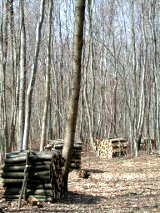
BILJOU
Forest water balance model
 - Silva Joint Research Unit
- Silva Joint Research Unit
⚠ ATTENTION : INTERRUPTION DU SERVICE DU 20 AU 24 MARS ⚠
⚠ WARNING: SERVICE INTERRUPTION FROM MARCH 20 TO 24 ⚠
⚠ WARNING: SERVICE INTERRUPTION FROM MARCH 20 TO 24 ⚠
Frequently asked questions
The technical options and approaches available to researchers are key advantage points for successful water balance modelling in forest stands supplied with water exclusively from rainfall and without irrigation. Numerous studies have shown the impact that changes in the canopy can have on water consumption, on drainage flow and constraints suffered by trees.
Forest managers and practitioners have sent in a wide range of questions: :
Related to current climate conditions: :
- Is it possible to compare levels of drought conditions suffered by a given stand over a period of several years?
- In my region, was the drought in 1976 more severe than the drought in 2003 or 2018?
- Did the observed dieback result from recent drought events?
Related to a changing climate: :

- If phenology is modified with future climate conditions, how will the water balance change?
- What would be the impact on the water availability in my stands if the future climate follows a RCP 4.5 scenario? On the other hand, would it be even worse with RCP 8.5?
- As the climate changes, how is it possible to quantify the changes in soil water deficit to which forest stands will be submitted?
- What is in the future the probability of occurrence of years with similar soil water deficits those experienced in the past (1976, 2003, and 2018)?
- What leaf area index would be required under future climate conditions to maintain soil water deficits at levels similar to those observed in the past?
Related to canopy type: :
- What is the difference in the water consumption for deciduous and evergreen forest stands?
- What is the difference in water consumption between trees and the herbaceous sub-layer?
- How does this consumption change throughout the year?
Related to the soil: :

- For a given climatic year, how do differences in the soil properties induce differences in a stand’s water stress levels?
- What are the periods in the year when differences in the soil water reserve have the most impact on tree growth?
- Would substituting a shallow-rooted species for a deep-rooted one mitigate soil water deficits?
Related to forestry operations: :
- Is it possible to quantify the trees improved water comfort if the stand is thinned?
- How can the canopy be adapted to economize water consumption?
Related to the water cycle: :
- What are the impacts of drainage and watershed flow on forests?
- Is the partitioning between green and blue water influenced by deciduous or evergreen cover type?
- What are the impacts of substituting deciduous forests with softwood plantations on drainage and watershed flow?
Related to geographic variations in forest water deficits: :
- What was the geographic extent of the exceptional 2003 and 2018 drought events?
- What are the average soil water deficits experienced by forests in the large French ecological regions?
- In which year was the drought anomaly most severe for deciduous forests? And for evergreen forests?

